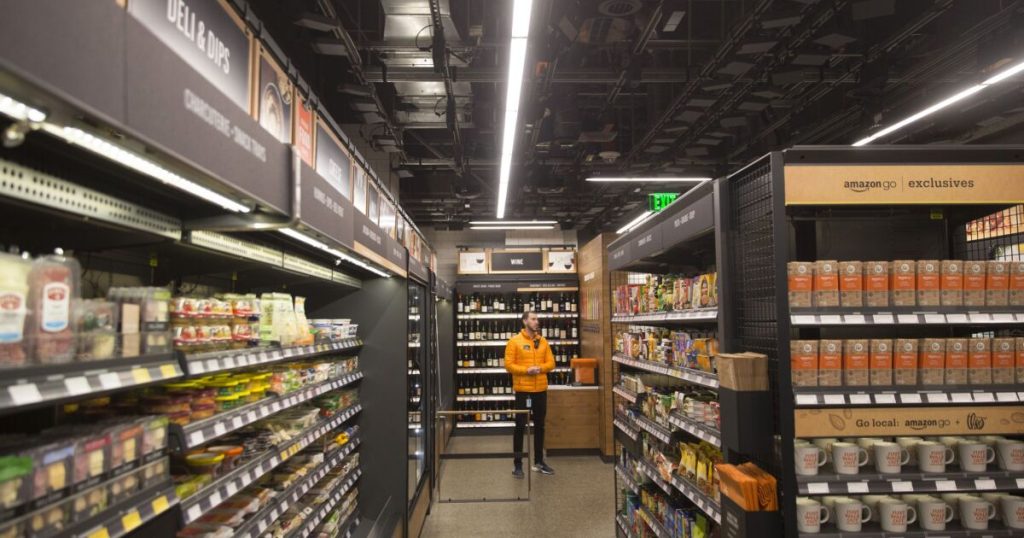Mike Kane/Bloomberg
A new form of self-checkout that enables shoppers to pay and retailers to gather data without a point of sale terminal is starting to make steps toward the mainstream.
Zippin, a company that builds checkout-free retail, has deployed its technology at 15 stores in the past two months, including a concession location at the Capital One Arena. Zippin’s technology allows shoppers to scan an app or swipe a credit card to enter a store and pick up what they need. The purchases are automatically charged when the shopper leaves the store.
If checkout-free retail like Zippin’s can become widely used, it could radically change more than just payments. In addition to the line-busting benefits of self-checkout, checkout-free retail uses technology that can inform dozens of functions for mobile wallets and other banking or financial services apps, fueling cross-sales, customer service, personalized marketing and even artificial intelligence-powered commerce.
“The technology for such ‘shop and go’ solutions is always improving,” Zil Bareisis, head of retail banking and payments research at Celent, now part of GlobalData, told American Banker. “However, it can still be expensive to install and operate, particularly for larger stores selling a broad range of items.”
How does checkout-free work?
Checkout-free generally refers to stores that use sensors to identify items that consumers are taking off of shelves, then charging those consumers’ e-commerce accounts automatically. The key point in the process is “checking in,” which authenticates the user beforehand, with minimal staff required to aid shoppers and provide security.
Amazon and Zippin did not return requests for comment.
While Amazon Go’s network has not expanded, Amazon has found demand for the technology elsewhere. Amazon has made more than 200 deployments of its Go technology, including Lumen Field in Seattle, Commanders Field in Landover, Md., and M&T Bank Stadium in Baltimore.
Sports teams are among the first in line to use the technology, often in purpose-built facilities. Other sports deployments include Globant’s recently opened checkout-free
“This technology can be highly suitable in locations with limited product range and significant foot traffic, like stadiums, hospitals, academic campuses, airports, etc.,” Bareisis said.
There are about 15 Amazon Go stores in the U.S., and there are about 700 checkout-free stores around the world, with 200 in the U.S., according to Datos Insights.
“There is growth in this market, we’re seeing this in very specific use cases,” Alan Burt, senior manager and retail product lead for Datos Insights, told American Banker.
A data-rich environment
While the technology that supports checkout-free stores is difficult to deploy, there is ample incentive.
“Autonomous checkout isn’t about checkout,” Richard Crone, a payments consultant, told American Banker. “It’s about capturing first-party behavioral and [stock-keeping-level] purchase data.”
The sensor technology can measure the amount of time consumers spend looking at items, what items they did and didn’t purchase, how they responded to special offers, and how much overall time they spent in a store. This can provide data that can be fed into an artificial intelligence algorithm and can produce messaging for cross-selling or marketing, or to enhance payment capabilities for a bank’s mobile app.
Google traditionally owns this type of digital shopping data but is now being re-anchored in retail and digital wallet-linked credentials, setting the foundation for agentic commerce, Crone said.
This puts Amazon, which operates the Amazon Rufus agentic commerce platform, in competition with similar
A key advantage for Amazon will be Rufus’ integration of offline-to-online behavioral data from its Just Walk Out technology, which will be licensed to third-party retailers and e-commerce platforms to make Amazon’s agentic algorithms more powerful, Crone said.
Another key element for checkout-free retail is consumer appetite.
While checkout-free retail is mostly not available, its predecessor, self-checkout, is steadily expanding. The number of retailers with self-checkout grew from about 3,000 in 2021 to 10,000 in 2024 and is expanding at a rate to reach 24,000 by 2030, according to
Capital One’s research also reports that 80% of consumers use self-checkout, and 49% use it all or most of the time.
Among traditional retailers, Sam’s Club recently announced a fully self-checkout store model, requiring shoppers to use the retailer’s app to make payments.
“We tend to forget that the checkout process is a friction in the shopping experience. Most merchants would likely prefer that purchases be made without a checkout process to save on costs and improve the customer experience,” Tony DeSanctis, a senior director at Cornerstone Advisors, told American Banker. “Ultimately the checkout process will become less and less a part of the shopping experience long term, but I am not sure we are ready just yet for a fully checkout-less experience.”

